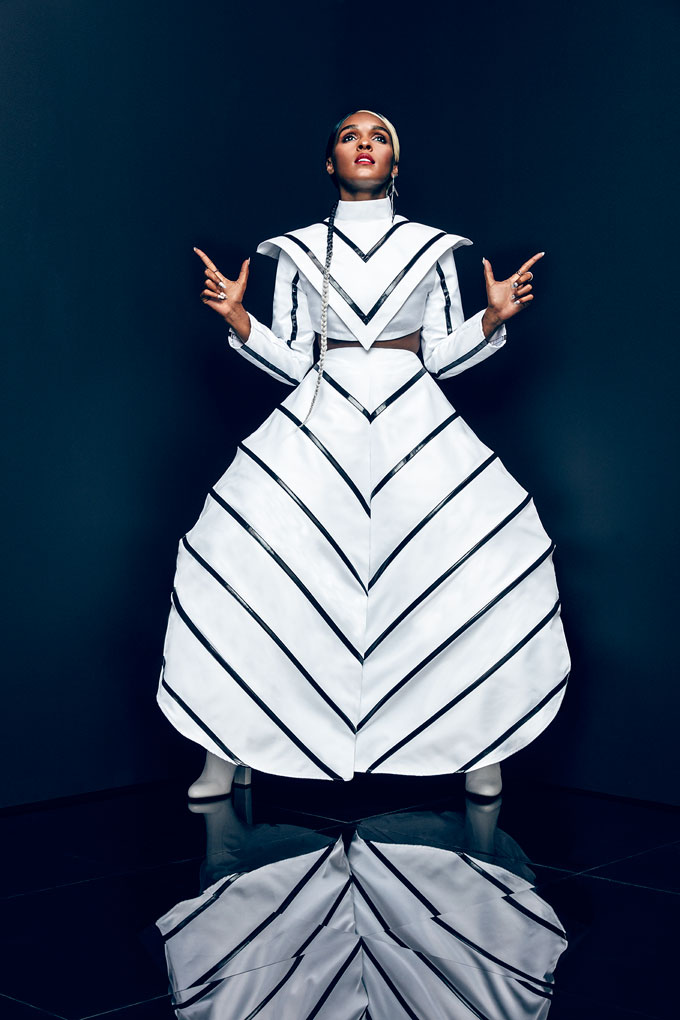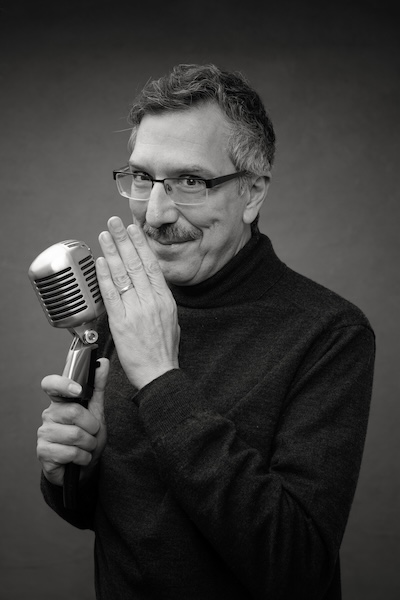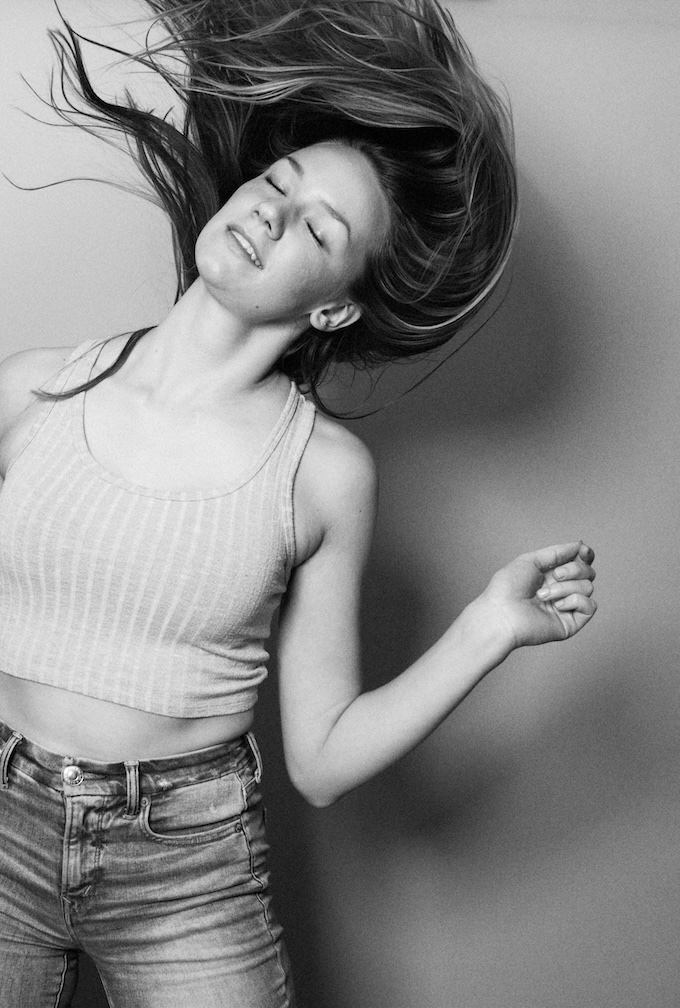Beauty, Glamour + Fashion
How a Fashion Photo Duo Balances Cohesion and Creativity
November 16, 2018
WHY YOU SHOULD KNOW THEM
Julia Johnson and Cody Cloud’s collective fashion, editorial and commercial work has adorned the pages of New York magazine, Paper, The New Yorker, Billboard and Vogue, among many more.
jucophoto.com | @jucophoto
Julia Johnson and Cody Cloud, the photographers that make up JUCO Photo, deserve to get a dream assignment. Having hustled for nearly a decade side by side, they are recognized for their graphically bold, playfully crafty aesthetic. This year, they were tapped to shoot the artwork and promos for Dirty Computer, the album released to critical acclaim by singer and rapper Janelle Monáe (she’s also an actress, having appeared in Hidden Figures and Moonlight).
“I really, really respect her as an artist,” Johnson says in a phone call from the team’s home base in L.A., “and I think she’s super, super talented and somebody that walks to the beat of her own drum. It was very exciting to shoot that.”
This was by no means their first brush with celebrity portraiture, having photographed the likes of Sam Smith, Elizabeth Moss, Lena Dunham, Solange Knowles, Kim Kardashian, Kylie Jenner, FKA Twigs, A$AP Rocky, and even DJ Khaled’s baby son, Asahd. And while this has certainly been a 2018 career highlight, they also wouldn’t place more value in these big-name assignments over their pick-up-and-go, small-crew, analog-only shoots, for publications or just for fun.
They have a good thing going, but did they know that would be the case 12 years ago, when they first began collaborating? “We just guessed at that part,” Cloud says with a laugh. “We didn’t know it was going to work.” That could be because, despite the impressively cohesive style and brand identity over the years, these are two very different people.
A Conscious Coupling
Johnson grew up in Miami Beach. Having a father who worked with Elite Model Management in the ‘90s, she says, “I just remember seeing incredible contact sheets floating around. I’ve always been interested in fashion, but in the very beginning I didn’t even know to look at certain photographers. I was just looking at magazines.” She started taking photo classes in high school but then went to Florida International University to study marine biology before a professor encouraged her to switch her major to photography. Johnson soon found herself pursuing a bachelor’s degree at the San Francisco Art Institute—that’s where she’d meet Cody Cloud, who was getting his masters. A Phoenix native, he had studied photography and German at Arizona State University for his undergrad. Photography was always an interest, Cloud says, but he grew into fashion, after first rooting himself in the more traditional, “old-school masters” of the medium.
Johnson says her early work looked like “subdued, moody, girly images—a lot of self portraits and portraits of friends looking like they were feeling something real.” Meanwhile, “Cody could photograph literally anything and be happy and content,” says Johnson, the more comfortable raconteur compared to a quieter Cloud. “He took pictures of a lot more inanimate objects and scenes.”
As time went on, they built upon their own separate bodies of work, with their collaborative work taking on a distinctly color-infused, fashion-focused aesthetic that’s more closely aligned with present-day JUCO. “At one point,” Johnson recalls, “a client said, ‘Look, I’m confused, I don’t really know who to hire—do I hire JUCO, do I hire Cody, do I hire Julia?’ And [with] that feedback, we just decided that, look, if we’re going to do this, we should just do this whole hog and really commit to the partnership and our dual vision. And that’s what we did.”
Dividing And Conquering
That was nine years ago. At this point, Johnson and Cloud have JUCO down pat. Though they may take different routes getting there, they know what they want to create together. They never shoot a subject at the same time—only one of them is ever holding the camera at any given shoot—but their back-and-forth method works, not least of all because they’ve both assumed fairly distinct roles on set.
Johnson, being more and more interested in “the process of getting to the place of image-making,” she says, organizes the creative team of stylists, hair and makeup artists and set designers, sharing and “cooking up” creative for the day. “I sometimes feel like by the time I walk on set, my job is done,” she says. “And I still love taking images, but that part of the project is less important to me now.”
Cloud is more involved with the technical side of the shoots—gathering the gear, setting up the lights and working with the photo crew on set. And when it’s time to come together and shoot, Johnson says, “We just sort of seamlessly trade off, and that sort of happens organically, just depending on how we’re feeling, how the subject’s feeling. It’s just like, you want to shoot this, I want to shoot this; this person likes Cody, this person likes me.”
“It’s just easier to run a set together, and we both trust one another,” Cloud adds, “but one of the biggest advantages of working as a partnership is being able to bounce ideas off of one another beforehand. That’s where we are really strong, in my opinion.” They both keep ideas folders where they store specific concepts they want to do, whether for an assignment a week later or something they may do a few years down the line.
“When it’s very specifically like, we have to put together a treatment, this is due on Monday,” Johnson explains, “the general creative process is that Cody and I separately go our own ways and sort of marinate and accumulate different things, like references, sketches.”
“For me personally,” Cloud says, “that creative process is super organic. I could be inspired by something I see in the gutter. It doesn’t take much for me. And we look at tons of work just to know what’s going on around us.”
“And then we come back together,” Johnson says, “and compare, contrast, what’s good, what’s not working here, what do we want to whittle this down to, and then go from there.”

Taken in a greenhouse in Johnson’s old backyard, a personal, bittersweet shoot for New York magazine’s The Cut.
An Evolving Identity
This open dialogue has proven to not only help one another develop ideas, but also to not fall into an abyss of self-doubt. “If you’re a solo artist,” Johnson explains, “you spend a lot of time internalizing, beating yourself up. But for us, it’s a constant external dialogue of, where do we want to go? What do we want to be doing? How could we have done that better? It’s not this crumbling, devastating feeling; it’s more like this productive, constructive conversation.”
This year, personal evolution came in the form of a shoot that took place in Johnson’s old backyard, a couple of acres “with a bunch of greenhouses,” Cloud describes. “Julia was getting evicted from her house wrongfully, so it felt really good to go back there and utilize that.”
Johnson chimes in to explain: “My landlord died and the trust that took over displaced a bunch of families, unfortunately, but he was this incredible plant person and the spaces were kind of wild and grown over. We were able to go in there just a month or so before I moved out and captured the story.”
It was an editorial shot on film for New York magazine’s The Cut, featuring model Lotte Van Noort wearing different dresses and eclectic ensembles. It was all done with “a very small crew,” Johnson says, where “we can just act with our instincts.” A spontaneously structured shoot like this is Johnson’s favorite kind to execute. “It’s always without pressure, it’s always without expectation,” she says, like shooting models on the beach for The Washington Post, or setting up an in-studio, Jell-O-infused color story for Paper, or wandering the Technicolor Salvation Mountain in the California Desert or the artfully patterned Greenbrier hotel in West Virginia. “It’s just like, let’s just go to this place that’s great and see what happens.”
The duo has even more creative work to look forward to in the months to come, including some video projects coming up, Johnson hints, and they also expect to be shooting more editorials on film. “It’s interesting to be doing video and then sort of digging our fingers back into the analog sector,” says Johnson (they were both trained in the darkroom). “It’s like a yin and a yang.”
And much like that visual, JUCO is nestled in kind of a sweet spot, albeit one that invites more self-exploration. “We’ve been lucky enough to have a few prolific years,” she says, “and we need to actually stop and focus on what our next moves are and who we want to be reaching out to and working with more.”
And yes, they’ll be brainstorming all of those moves out loud together.
Cameras: Canon 5D Mark III, Canon 5DS R, Rolleiflex, Mamiya 7II, Yashica T4, Ricoh GR1, Contax G2, Linhof Technika 4 x 5, Fuji GA645, a couple of old Land cameras
Lenses: Canon L series 24-70mm, 50mm, 85mm and 70-200mm; 40mm “pancake”
Lighting: Profoto 8A, 7B, Acute 2R
Related: A Photograher You Should Know: Celebrity Shooter Miller Mobley
Making a Move to Styled Editorial Shoots for Top Magazines
Should You Become a Photography Duo?
How Fashion Photographer Emily Soto Stays Avant Garde With Film





